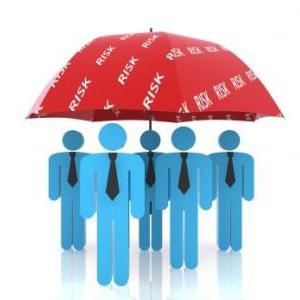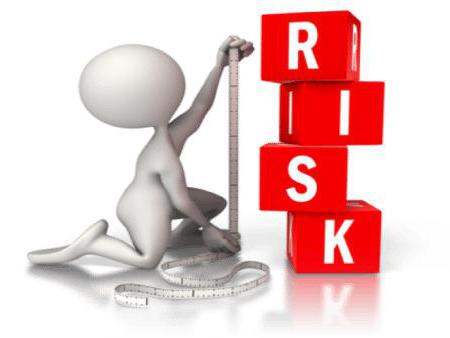The economy is associated with the planning and allocation of resources. But they are not produced in an ideal airless space, but in a living environment. Economic processes are always affected by external and internal risk factors. To discover, take them into account, minimize their influence - these are the tasks of the economist and manager. We will talk about what external risks are, what are their varieties and what methods of managing them exist.

Risk concept
In business, internal and external risks are a natural component. Any businessman must understand that his business may cease to be profitable, may cease to exist under the influence of various factors, etc. An entrepreneur, starting a business, assumes responsibility for all risks, therefore he must well understand what awaits him on the way to income. Risk is the probability of losses in the adoption and implementation of economic decisions, due to a variety of different reasons. Specific risk features are associated with uncertainty, with uncertainty in circumstances, with assumptions and hopes for a positive outcome, based not on facts, but on hypotheses. Researchers have traditionally identified features such as uncertainty, inconsistency, and alternativeness in risk.

Risk functions
In entrepreneurial activity, it is customary to consider risks as something a priori negative. However, they perform a number of functions, thereby contributing to the development of the business. The first risk function is stimulating. It is the motive for conducting research, for substantiating decisions. The protective function is related to the fact that businessmen, assuming risks, are looking for legal, social and other forms of protection of their business from possible consequences. Compensating function - with the fact that the presence of risks is usually associated with increased remuneration, income, satisfaction, appearing with a successful result. The socio-economic function is associated with the identification in society of areas of activity and groups of people in which the risk is considered acceptable.
Risk factors
The hazards to business success are usually called risk factors. They carry hostile, destructive properties and are capable of harming the enterprise or causing losses of various sizes. Usually emit factors of the external and internal environment. They can be predictable and unpredictable. The former are associated with various phenomena and causes that are known from world business practice or economic theory. Usually they arise under a certain set of circumstances. Unpredictable are those that arise suddenly, for the first time in the economic practice of an enterprise, industry, or economy. Internal and external risks can be caused by various factors, usually their number is very large. They are also usually classified according to degree of significance. The most important are paid more attention, while the minor ones are sometimes simply ignored when making economic decisions. Risk factors can also be divided into manageable, difficult to manage and unmanageable.

Types of risks
There are many classifications of risks. This diversity is due to the fact that unforeseen situations are almost endless. The division into internal and external risks is traditional. In each of these groups, various subspecies can be distinguished. It is also customary to divide risks into pure and speculative. The first are simple circumstances that almost always lead to losses.These include, for example, accidents, wars, natural disasters. The second group is associated with dynamics that can bring both losses and profits. For example, currency fluctuations. Risks can also be divided into subjective, i.e., arising due to the characteristics of the entrepreneur’s behavior, and objective, arising due to reasons beyond the control of the businessman. It is also possible to classify hazards according to the harm done and highlight the risks that cause difficulties, significant risks and catastrophic.
External and internal risks in the economy
The business affects the environment, and it can be both internal and external. The main difference between external and internal risks is associated with the ability or inability to influence them, to manage them. Usually, an analysis of external risks makes it possible only to see certain dangers, but it is difficult to influence them. At the same time, internal risks usually lend themselves well to correction by the entrepreneur. As less manageable and more diverse, external risks are more often investigated in management.

Types of external danger
The business environment is constantly fraught with various dangers. There are many varieties of external risks. They are traditionally divided into risks of direct exposure and indirect exposure. The first include regulatory laws, actions of the government and the state, tax authorities, competitors, relations of partners, corruption actions. The second group includes politics, the economic situation in the country and industry, the international situation, various force majeure circumstances.
Also distinguish such types of external risks as:
- Institutional, they are associated with poor-quality performance of their duties by managers and staff;
- pre-production, they appear due to errors at the planning and start-up stages of production;
- production, they appear during the implementation of the project;
- sales, they are associated with difficulties in the sale of products, strategies for promoting goods from producer to consumer;
- financial, they appear as a result of an incorrect financial strategy, with the instability of the economic condition of the enterprise;
- legal - this group of risks arises from the actions of state bodies;
- industry-specific, they are determined by the state of the sphere of activity in which the business is being implemented;
- force majeure - any enterprise depends on natural disasters, emergencies, wars.
There are also a number of other external risks that can damage a company. There is a classification within which risk groups are identified in accordance with the occurrence factor; it includes: economic, climatic and political risks.

Forecasting
Any enterprise is ready to spend quite impressive resources on predicting risks and avoiding them. Internal and external risk factors are predictable; various methods are used for this, including:
- Statistical. They are based on the calculations of various data obtained at certain periods of time. These are the simplest methods, but they can only be used if there are digital indicators, and this does not always happen.
- Expert. Built on the basis of interviewing specialists in certain industries.
- Socio-economic. Based on the analysis and assessment of economic experience in the past.

Rating
When threats have already loomed over the business, you need to correctly evaluate them in order to develop a program of action. Risk assessment is a set of analytical actions that can not only identify the causes of risk, but, most importantly, help minimize their consequences and prevent their recurrence. Environmental risks can be assessed using the collection and analysis of statistics, analogies, expert assessments and cost-benefit analysis.Statistical methods are built around the analysis and calculation of profits, losses and costs. The analogy method is associated with the analysis of similar situations in other enterprises. Expediency of expenses is estimated on the analysis of financial stability of the company. Typically, an enterprise develops its own mixed risk assessment methodology in accordance with industry specifics.

Management of risks
In an attempt to mitigate external risks, enterprises can use several methods. It:
- Acceptance of risks, i.e. managers, understanding all the dangers, are ready to act and bear losses in case of failure.
- Disclaimer of risks. If it seems to managers that the risks are excessive or their consequences are detrimental to the business, they can veto certain decisions.
- Delegation of responsibility, outsourcing of risk functions. Company executives may fully or partly assign risks to third parties. For example, to insurance companies.
Also, in order to manage risks, it is possible to apply methods such as loss prevention, damage reduction, hedging, combining risky assets into common portfolios.
Risk management
Studying environmental risk factors and ways to manage them, management theorists highlight a special area of activity for managers - risk management. It involves the adoption and implementation of management decisions in order to reduce losses and minimize risks. Usually in this activity the following sequential actions are distinguished:
- risk identification, forecasting its consequences, assessment of possible losses;
- selection of optimal methods for managing these risks;
- development of a strategy to reduce possible risks and reduce the consequences of damage that has already occurred;
- implementation of the strategy into life;
- assessment of completed actions, correction of the strategy. And then - in a circle, if the risks have not disappeared.
Reduction methods
Any company always seeks to reduce risks. In management practice, several basic methods have been developed to reduce their impact on production processes. It:
- Insurance. It can be internal and external. With the latter, everything is obvious - a third-party organization takes the risk for a fee. And internal insurance is associated with the creation of special stabilization funds, stocks of raw materials, etc.
- Diversification. There is a saying about eggs that should not be put in one basket - this is the essence of diversification. Enterprises should not rely on only one source of income, and distribute resources in several industries.
- Limitation. The method is associated with limiting the amount and volume of transactions, they are determined based on the financial stability of the enterprise and indicators that ensure the level of survival of the company.